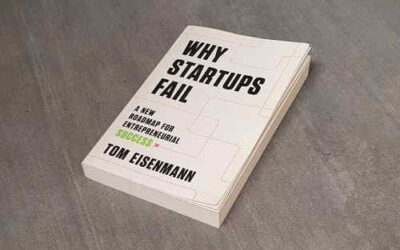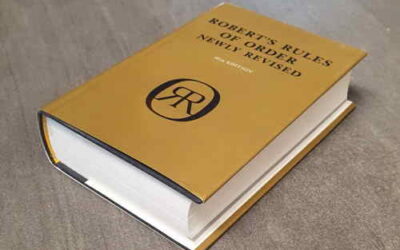A guide for fast and fair voting
This guide explains procedures for fast and fair voting in meeting of industry groups, alliances and consortiums. The chair learns how to keep it simple, avoid unnecessary votes, and help the participants understand what is going on.
Table of Contents
- Voting in meetings of industry groups – constraints
- How to quickly vote by consensus
- How to do a simple Yes/No vote
- How to vote when participants have 3 or more options to choose from
- 4.1. Ranked voting
- 4.2. Approval voting
- 4.3. Approval voting or ranked voting?
- How to vote when participants must choose a number
- Quorum, abstain votes, and majority calculations
- How and when to make votes confidential
- Votes to avoid
- Guidelines for the chair
- Tools for voting in meetings of industry groups
- Background literature
1. Voting in meetings of industry groups – constraints
The meeting of an industry alliance needs rules and procedures for making decisions. When designing voting rules and voting procedures for an industry group, typical constraints are:
- The members of an industry alliance are companies. These companies have the right to vote, usually one vote per company. Counting votes is complicated when there is more than one representative per company participating in the meeting.
- Some companies represented in the meeting may not have voting rights. That could be, for example, when voting rights depend on attendance in previous meetings.
- Some (or all) members will participate remotely, using on-line meeting facilities. It is not possible to use voting procedures that assume people are in one room.
- Language barriers and cultural differences can make it difficult for some participants to understand what a vote is about, and even more difficult to speak up and debate a voting procedure.
Robert’s Rules of Order is a good source on voting procedures. I don’t like how meetings are managed under Robert’s Rules of Order, but Chapter XIII on “Voting” is readable and useful.
In this article I explain how to make the most common voting procedures work, taking the unique requirements of industry alliances into account, while staying close to Robert’s Rules of Order.
2. Voting by Consensus
The alliances I work with take most decisions by consensus. The typical procedure is:
- Chair: “Does anyone oppose taking this decision by consensus?”
- Chair waits a couple of seconds.
- Chair: “Hearing none, the proposal is approved by consensus”
3. How to do a simple Yes/No vote
A vote by the members is needed when consensus is not possible. A decision to approve or reject a proposal is most easily done by a roll-call vote.
The procedure is:
- Chair shows a list of companies with voting rights on a screen where all participants can see the list.
- Chair calls the names of the companies one by one.
- Each representative replies with “we agree” or “we don’t agree”, or “we abstain”.
- Chair writes the vote of that company on the screen, for everyone to see.
- Chair announces the result after all companies have been asked to vote
A spreadsheet, like this one, will make it easy.
Start at a different place in the list with each new vote. It is not fair to always start with company “ABC, Inc.” and end with “ZYX, Inc”.
- Chair: “After listening to the discussion, it appears that the majority is in favor of approving the proposal. Does any wish to do a roll-call vote, or can we agree that the proposal is approved?”
- Chair waits a couple of seconds.
- Chair: “Hearing no requests for a roll-call vote, the proposal is approved”
4. How to vote when participants have 3 or more options to choose from
A roll-call vote doesn’t work when the members need to choose between red, green, blue, or yellow, for example. Or choose between candidates Alice, John, Sarah and Manuel to be elected as chair of a work group.
There is an extensive literature about voting procedures for this type of vote, covering many variants. For industry alliances there are two suitable methods, “Preferential Voting” and “Approval Voting”. Repeated voting (“Run-off Voting”) as used in presidential elections is considered impractical for industry groups because it takes too much time.
4.1 Ranked voting (also called “preferential voting”)
In Ranked Voting, each participant ranks the candidates sequentially. Robert’s Rules of Order calls this method “Preferential Voting”.
This is what the voting form looks like when there are four candidates:
| 1 | 2 | 3 | 4 | |
| Alice | ☐ | ☐ | ☑ | ☐ |
| John | ☐ | ☐ | ☐ | ☑ |
| Sarah | ☑ | ☐ | ☐ | ☐ |
| Manuel | ☐ | ☑ | ☐ | ☐ |
Counting is done with a procedure in that repeats until the winner is determined:
Step 1: Allocate all votes to the candidate that are ranked “1” on the voting form.
Step 2: Does one of the candidates have more than 50% of the votes? That candidate has won the election.
Step 3: No winner yet? Take the votes of the candidate with the smallest number of votes and re-distribute these votes over the remaining candidates. Each vote goes to the remaining candidate that has the highest preference on that voting form.
Step 4: Go to step 2.
Example of a ranked voting procedure
10 members cast a vote in this election by filling in the voting form. These 10 votes are:| Rank 1 | Rank 2 | Rank 3 | Rank 4 | |
| V1 | Alice | Manuel | John | – |
| V2 | Alice | John | Sarah | Manuel |
| V3 | Alice | John | – | – |
| V4 | Alice | Sarah | Manuel | John |
| V5 | John | Manuel | — | |
| V6 | John | Manuel | Sarah | Alice |
| V7 | John | Manuel | Alice | Sarah |
| V8 | Sarah | John | Alice | Manuel |
| V9 | Sarah | — | – | |
| V10 | Manuel | John | Alice | Sarah |
| Candidate | Allocated Votes | Percentage |
| Alice | V1, V2, V3, V4 | 40% |
| John | V5, V6, V7 | 30% |
| Sarah | V8, V9 | 20% |
| Manuel | V10 | 10% |
| Candidate | Allocated Votes | Percentage |
| Alice | V1, V2, V3, V4 | 40% |
| John | V5, V6, V7, V10 | 30% |
| Sarah | V8, V9 | 20% |
| Candidate | Allocated Votes | Percentage |
| Alice | V1, V2, V3, V4 | 45% |
| John | V5, V6, V7, V10, V8 | 55% |
| Not valid | V9 | – |
4.2 Approval voting
In Approval Voting, each participant selects all candidates considered suitable. There is no ranking.
This is what the voting form looks like when there are four candidates:
| Alice | ☑ |
| John | ☐ |
| Sarah | ☑ |
| Manuel | ☐ |
Counting votes is easy in this case. The candidate with the highest number of votes is the winner.
If the rules of the organization require that a winner must have more than 50% of the vote, it may be necessary to organize a 2nd vote when the candidate with the highest number is below 50%. In that 2nd vote, the candidate with the smallest number of votes is removed from the ballot. In practice that happens only when (a) most participants select only one candidate out of many candidates and (b) all candidates are controversial.
4.3 Approval voting or ranked voting?
There is usually not much difference in outcome between Approval Voting and Ranked Voting. The outcome could be different only when there is one candidate supported by the majority and unacceptable by a minority of the members. In that case the controversial candidate will win a Ranked Vote while a non-controversial candidate may win an Approval Vote.
I prefer to use Approval Voting as voting procedure for industry alliances because (a) counting votes is simpler, (b) members don’t like being forced to rank candidates, (c) Industry Alliances are usually better off with non-controversial elected chairs and officers.
What if two candidates end up with the same number of votes?
It is possible in both Approval Voting and Preferential Voting that it is not possible to determine the winner when two candidates end up with the same number of votes. There are two solutions:- A run-off election between the two remaining candidates.
- Decide by flipping a coin
5. How to vote when participants must choose a number
What if the vote is about increasing the membership fee and the participants need to choose a number between US$ 1000, US$ 2000, US$ 3000, US$ 4000, and US$ 5000?
In this case the alliance may want to choose the highest increase that is supported by a majority of the members instead of choosing the option that is supported by most members.
Approval Voting and Preferential Voting don’t work when the goal is to select the highest acceptable value from an ordered list of options.
In a vote on a sorted list of options, it is necessary to vote first on the option that creates the highest impact on the organization. In this example, the chair starts with the proposal to increase the membership fee with US$ 5000. No further voting is needed when that proposal is accepted. If the proposal is rejected, the chair proceeds with voting on an increase with US$ 4000. And so on until a proposal is accepted. The membership fee remains unchanged when none of the proposals is accepted.
It is also possible to do this in a single vote with a multi-choice ballot:
| Highest increase supported by my company | |
| US$ 0 | ☐ |
| US$ 1000 | ☐ |
| US$ 2000 | ☐ |
| US$ 3000 | ☑ |
| US$ 4000 | ☐ |
| US$ 5000 | ☐ |
Note that US$ 0 option must be included in the multi-choice ballot to make it possible to reject any increase.
A vote for US$ 3000 is counted as vote for US$ 3000, US$ 2000, US$ 1000, and US$ 0. The winner is the highest increase that has the support of more than 50% of the votes cast.
It is not always obvious that it is useful to treat a vote as a choice between ranked options. It should be a deliberate choice and discussed and agreed with the participants beforehand. Without explicit prior agreement, the default will be to use the voting procedure for choosing between independent options.
6. Quorum, abstain votes, and majority calculations
Industry alliances usually require that a minimum number of members participates in a vote. This is called “Quorum”. It is usually at least 50% of members with voting rights, but can also be another number. Quorum requirements may also depend on the topic of vote.

7. How and when to make votes confidential
A confidential vote does not disclose how each member has voted. Only the outcome (number of votes that were cast and the percentage in favor) is disclosed to the members.
A vote about persons (an election for example) should always be treated confidentially.
Most Industry Alliances have as default rule that it must be possible to see how each member voted (except for votes about persons). That can make it difficult for a company to vote freely on proposals that go against the interest of a large customer. It is, therefore, advisable to make it possible for members to ask for a confidential vote. The rule could be that the chair must make a vote confidential on request of (for example) 15% of the members with voting rights.
The simplest way to execute a confidential vote is by email to a person who is trusted to maintain confidentiality. That may be the legal counsel, for example, or an independent contractor.
8. Votes to avoid
It is good practice to avoid voting on proposals that not fully defined or votes that have no consequences.
It can be tempting to issue a “straw poll” or “opinion poll” to get a sense of what the members want. Don’t use a vote. The correct way is to issue a survey, or to have a discussion in which members can express their views. A vote is a decision. Votes need to have consequences. See also Robert’s Rules of Order, 10th edition p.415 “Straw Polls Not in Order”.
It can also be tempting to vote on a proposal with text like “We tentatively agree to ….”, with the idea that will probably be done, but may be decided differently at a later date. Not a good idea.
9. Guidelines for the chair
The chair is responsible for making the vote fair. There are a couple of rules that will help:
- The text of a proposed decision must be visible on-screen for everyone to read. Voting on a proposal that has only been verbally explained is acceptable only when it is a trivial decision that will obviously be approved by consensus.
- Give participants time to speak up. Wait long enough to allow on-line participants to unmute their microphone when asking if anyone is against taking a decision by consensus.
- Explain the effect of approving the proposal and rejecting the proposal. What are the consequences? Spend time on making that explicit when the topic of the vote is not trivial.
10. Tools for voting in meetings of industry groups
All voting procedures can be handled with spreadsheets and email, but support with tools will make it easier for members as well as meeting facilitators.
Almost all on-line tools are meant to support elections and not really suitable for making a large number of decisions during a meeting. ElectionBuddy advertises support for voting during meetings, but I have no experience with that tool.
Some organizations have built their own tools, integrating attendance registration, voting rights calculation depending on meeting attendance, on-line forms that are visible for members only, and an archive of votes. These self-built tools are complicated and hard to test but allow support for rules that are specific for the organization.
11. Background literature
https://en.wikipedia.org/wiki/Approval_voting
https://en.wikipedia.org/wiki/Ranked_voting
The “Guide to facilitate multi-party negotiations between companies” has useful tips for the meeting chair.




